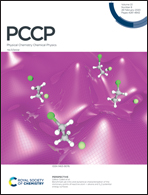Hydrophobic hydration and pairwise hydrophobic interaction of Lennard-Jones and Mie particles in different water models
Abstract
The study provides a deep computational analysis of the thermodynamic and structural features associated with the hydration of xenon, Xe, and its pairwise hydrophobic interaction (i.e., the potential of mean force, PMF), over a large temperature range. Xe is described both as a Lennard-Jones particle, LJ-Xe, and as a Mie particle, Mie-Xe (pseudo hard sphere). Three different water models are used: TIP3P-Ew, SPCE and TIP4P-2005. Mie-Xe is more hydrophobic than LJ-Xe due to the lack of the attractive energetic interactions with water molecules; its hydration, around room temperature, is opposed by a large and negative entropy change and a positive enthalpy change. The PMF of Mie-Xe is characterized by a deep minimum at contact distance whose depth increases with temperature, and whose magnitude is significantly larger than that obtained for LJ-Xe. The contact minimum configuration of Mie-Xe is favoured by a large positive entropy change and contrasted by a positive enthalpy change. These results are qualitatively the same regardless of the water model used. There is no clear connection between the values determined for the thermodynamic functions and the structural features of the hydration shells surrounding the single Mie-Xe and the couple of Mie-Xe particles in the contact minimum configuration. This confirms that the structural reorganization of water associated with such processes is characterized by an almost complete enthalpy–entropy compensation.



 Please wait while we load your content...
Please wait while we load your content...